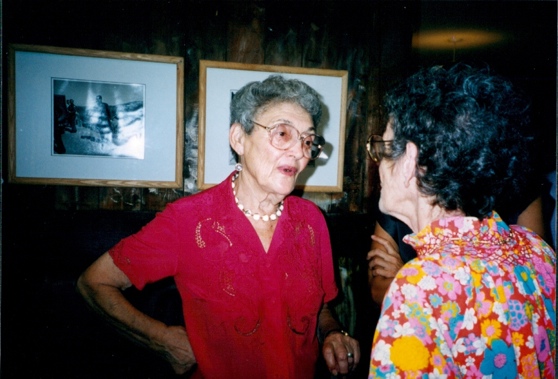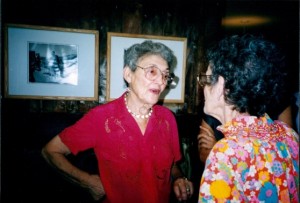

When 93-year-old Annette Finestone sold her hotel business in 1978, she never expected her husband to find a bag of her old film from Japan while rummaging through things.
“I found this film and I said, ‘Oh my god I ought to do something about it.’ They were just rolled up in a bag still, I didn’t even know I had them,” Finestone said.
Finestone’s job as a placement officer landed her in Nagoya, Japan after a job was unavailable in France. She arrived in Japan in 1945, six months after the bombing of Hiroshima.
Previously, Finestone had only fooled around with a Browning box camera, but she found herself intrigued by her surroundings and during her trip she purchased a unique Mercury camera which took half-frame film.
“Most of my photos are street scenes, things that I just captured on the streets and the life there was so different and intriguing to us that anything was interesting and fascinating,” Finestone said.
According to Finestone, Japan was completely devastated aside from the central parts of cities maintained for Americans and the Japanese treated them with a tremendous amount of fear.
She recalls a specific instance of this trepidation and how the Japanese eventually warmed to the Americans. Every day, Finestone would walk on the same road in the country and the field workers would look down under their hats. However, they eventually began to peer out from under the brims and one day a woman came over to the road and handed the photographer some eggs.
“She had overcome her fear and showed the friendliness and the gift giving of the Japanese,” Finestone said.
It was these types of people and situations that inspired Finestone to take the photographs. After discovering the film, she went to SUNY Ulster and spent five or six years taking courses and developing the film.
While Finestone has not taken photos since she was 85 due to progressive blindness, she showed four of her black and white photographs from Japan at an art show on March 11. The show took place at the Woodland Pond retirement center in New Paltz, where she is a resident.
One photo depicts a woman running in a devastated, bombed out area. When the woman saw Finestone she was so frightened and began running away, Finestone said. Another photo is of a roadside city scene with a woman and a carriage, which was an unusual thing to see.
An interesting piece featured was a photo of a group of people shown in two parts. The negative was so old and difficult to handle that it split in half while Finestone was working on it. Instead of throwing it out, she decided to try to enlarge each half and make it as one, like a “companion piece.”
The final photograph was one that Finestone discovered recently after she got to Woodland Pond and found an envelope of tiny pictures. The pictures had been developed in Japan, but never processed. The photo shows an archer during a boy’s week celebration, which was an event held every year when the boys turned thirteen, Finestone said.
Finestone felt proud to introduce the archer into her collection of work, debuting it at the show.
“Everybody just points at that picture,” Finestone said. “It’s actually almost like a magnet.”
Finestone continued to take photographs upon her return to the United States, primarily of people, but she regards her time and photography in Japan as her most important work with the greatest impact.
“It made my world larger, my understanding of what went on much broader, I went on to study the reasons for everything happening and the horrors that we perpetrated in Japan,” she said. “And then the photos just brought the reality back to me.”
Other artists featured in the show were Jane Lehman, Martin Davis and Natalie Minewski.
Lehman, a member of the psychology department at SUNY New Paltz, is a collage artist, whose career began 25 years ago in her small apartment when she needed art for the walls of her newborn son’s bedroom. She is very inspired by Frida Kahlo and uses a variety of materials such as acrylic paints, ink, wall paper, rice paper and fabric.
Davis is a local artist who mainly paints landscapes. His work strongly focuses on color and he gave the audience a brief lesson on the color wheel at the show.
Similar to Finestone, multi-media artist Minewski is a resident of Woodland Pond, but has ties to New Paltz tracing back to 1967. She graduated from Cooper Union in New York City, but received a degree in art education from SUNY New Paltz when her husband, well-known artist Alex Minewski, worked at the college. She then taught at the school for three years in the now defunct Innovative Studies department.
Minewski displayed work from multiple mediums, such as etching, monoprint and scratchboard. She described each method to the attendees, mentioning how etching uses a copper plate and a waxy ground, while monoprint uses a plexiglass surface and a press. Minewski does not have a favorite medium, but she was enthusiastic about scratchboard, a method which involves scratching away at an ink coated board.
“I feel as though I’m bringing the light out of the darkness,” she said. “The picture is in there and I’m bringing it out.”
Minewski is dedicated to keeping art a part of Woodland Pond, putting her art in hallways and trying to get residents together at least twice a month to “inspire each other and have an art workshop.”
The organizers of the event, village trustee Shari Osborn and The Dorsky curator Brian Wallace worked with Michelle Riddell of the Unframed Artists Gallery to put the show together.
They were very happy with how the artist salon went and the turnout, as many residents invited their family members to see the show.
Despite initial doubts, those at Woodland Pond appreciated the exhibition in the end as well.
“They were a little hesitant and we just kept pushing for it, saying it would just be up for a week,” Osborn said. “Now they said it can stay up for a month.”
